Cataracts
What are Cataracts?
Cataracts in most cases are a natural age related change to the lens inside the eye. About age 40 and up, we start seeing early signs of cataract changes occurring. Along with age, it is believed that smoking and diabetes can also increase our changes of developing cataracts. Being that this condition is mostly related to age, there is an increasing number of Americans that have cataracts currently or have had cataract surgery in the past.
Some of the most common symptoms associated with cataracts include blurred/hazy vision, double vision/diplopia, poor night vision, glare and halos around lights, and trouble seeing in dim lighting such as restaurants.
The most common types of cataracts are nuclear, cortical, and posterior subcapsular. Each of these occur most commonly due to the risk factors such as age, UV exposure, trauma, and high risk medications.
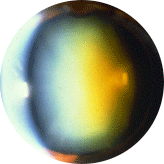
Nuclear cataracts are formed as a general facet of aging and can become more troublesome due to UV radiation exposure from the sun. With this type of cataract, the natural lens changes from clear to yellow to brown. As the density or color becomes more prominent in the lens, the patient starts to see more abrupt vision changes.
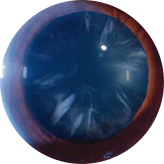
Cortical cataracts are very common and lead to a primary visual symptom of poor night vision. This type of cataract creates opaque spokes similar to that of a bicycle wheel that extend near or into the pupil and create a lot of glare, especially at night.
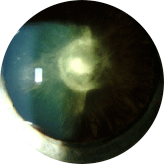
Posterior subcapsular cataracts are known to cause the most pronounced visual impact. These cataracts are typically fast growing and occur for numerous reasons. The most common reasons these cataracts can develop would be systemic illness such as diabetes or autoimmune conditions that require high or long term dosage of oral or injectable steroids.
At Carolina Optometry Associates, we evaluate the lens changes along with the visual system during your comprehensive eye health examination. This should be performed at least yearly to follow not only cataracts but other vision threatening diseases. Our highly trained doctors will determine if and when cataract surgery is the best option moving forward. We also will provide post-operative care and have numerous surgical referral groups that we co-manage with to give you the most convenient and comfortable care.
If cataracts are a concern for you, please feel free to contact our office and we will schedule an appointment as soon as is convenient.
Diabetic retinopathy
Diabetic Retinopathy
Diabetic Retinopathy is one of the leading causes of blindness in our middle aged population. A vast majority of patients who have been diabetic for over 10 years have some form of diabetic retinopathy. There are also many cases where the clues our doctors find in the routine eye exam that help in the first time diagnosis of diabetes. The vascular system can become fragile over the course of time with blood sugar changes and can lead to leakage within the retina. With earlier diagnosis and proper management, the cases of blindness resulting from this disease can be reduced drastically.
The changes that occur with the retinal blood flow occur in four stages:
Mild Non-proliferative Retinopathy occurs in the very early stages of vascular insult. This usually affects the small blood vessels within the retina and can lead to swelling and small hemorrhages.
Moderate Non-proliferative Retinopathy occurs when the blood vessels continue to change and create more hemorrhages and swelling. The hemorrhages in these cases are more profound and more numerous. Also, ischemia can start to form which damages healthy cells due to a lack of blood flow.
Severe Non-proliferative Retinopathy occurs when a vast area of the retina has hemorrhages and ischemia. There is typically more leakage from the blood vessels and the hemorrhages are much more pronounced as are the areas of ischemic retina.
Proliferate Retinopathy occurs when new blood vessels grow due to the current lack of blood flow within the retina. Since new blood vessels that grow in this manner are not complete, they leak resulting in more hemorrhage and a worse visual outcome.
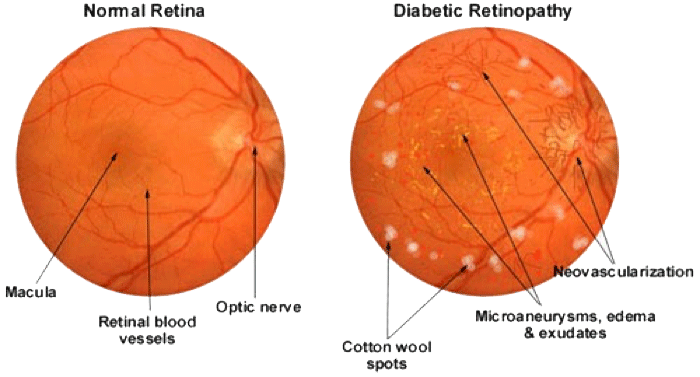
Here is a basic picture showing the difference between a normal retina and a diseased retina.
Dry Eye
Dry Eye
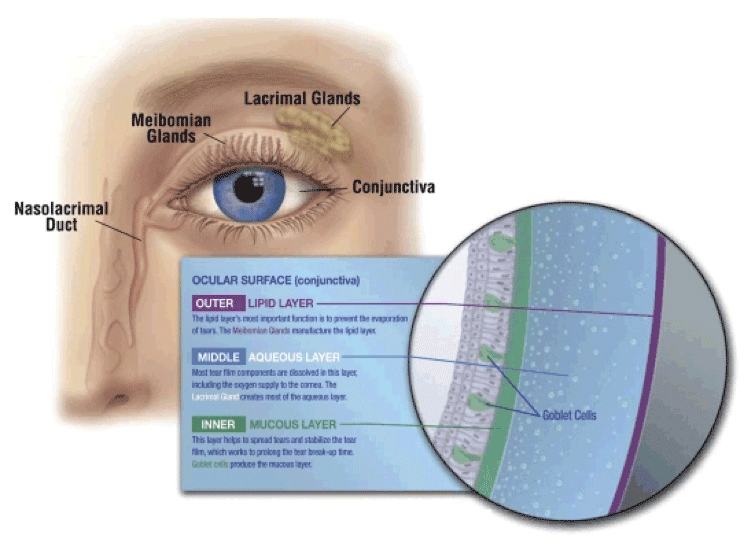
Image courtesy of Alcon
Age – Tear production decreases with age
Gender – Women are more prone to dryness due to hormonal changes through life
Medications – Antihistamines, antidepressants, decongestants, and blood pressure medications just to name a few
Medical conditions like thyroid conditions, diabetes or autoimmune disorders like rheumatoid arthritis can cause dry eyes.
Environmental conditions – exposure to smoke, wind, dry environments
Contact Lenses – In some cases, contact lenses can cause dry eye; however, this could be due to improper wear style or overwear of a specific type of lens. In many cases, changing habits or materials could alleviate the problems.
Examination of the surface of the eye and eyelids, as well as tests to measure tear production and quality can be used to determine whether or not one has dry eye. If you have any concerns regarding these symptoms, please contact our office for an appointment with one of our doctors. Our providers are well-trained in the diagnosis and management of this condition.
Macular Degeneration
What is Macular Degeneration?
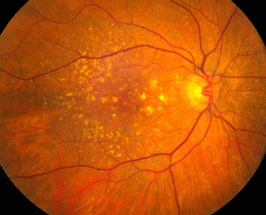
Dry AMD
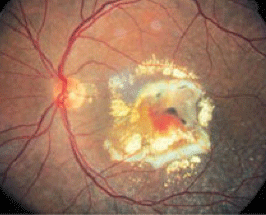
Wet AMD
At Carolina Optometry Associates, we can detect and form a plan of treatment for macular degeneration by simply performing your yearly comprehensive eye exam. Certain special testing may be required such as retinal photographs, optical coherence tomography (OCT), or fluorescein angiography to manage macular degeneration. The key is detection and monitoring with a bare minimum of yearly examination. In many cases, the special eye care needed for this disease requires more than one exam a year.
Treatment:
Currently, there is no treatment for dry AMD, though with close monitoring at our office, we can help detect changes to your central vision. Studies have shown that certain vitamin therapies can help to reduce the risk of the macular degeneration progressing. We also co-manage with retinal specialists regarding new and future therapy for treatment options. There is however a treatment for wet macular degeneration. Although the visual outcome of this type of AMD is worse, the possibility of halting or slowing the disease process is promising.
Given enough severity, macular degeneration can be very detrimental to every day tasks. Some patients may require vision aids to help them with things around the house and their job. Taking care of your vision now, by eating right, staying active, wearing sunglasses and refraining from smoking can help maintain healthy eyes.
At Carolina Optometry, we will offer you a full comprehensive eye exam that will allow us to detect this disease and determine the best possible course of action using state-of-the-art equipment and recommend therapies that our engaging providers feel is in the best interests of our individual patients. In the event surgical intervention is required, we can refer and co-manage all of our cases with highly specialized retinal surgeons.
If you feel that you meet any criteria listed above or have any of the risk factors for this disease, please feel free to call to schedule an appointment with one of our experienced eye doctors.

Recent Comments